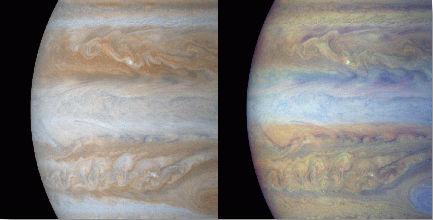True and False

| PIA Number | PIA02877 |
|---|---|
| Language |
|
Jupiter Clouds, True Color and False to Show Heights
January 23, 2001
These two frames of composited images taken by NASA's Cassini spacecraft
show the same cloud patterns on Jupiter both in natural color (left) and
in a false-color combination (right) selected to show differences in clouds'
height. The white spots in the right frame are storms high in the atmosphere.
Each frame is a combination of images taken by Cassini's narrow-angle camera
through different filters on Dec. 31, 2000, one day after Cassini's closest
approach to the planet. The smallest features are roughly 60 kilometers
(40 miles) across.
The left frame shows the colors Jupiter would have if seen by the naked eye.
The right frame is composed of three images. Two were taken through filters
centered on regions of the spectrum where the gaseous methane in Jupiter's
atmosphere absorbs light, and the third was taken in a red continuum region
of the spectrum, where Jupiter has no absorptions. The combination yields an
image whose colors denote the height of the clouds. Red regions are deep water
clouds, bright blue regions are high haze (like the blue covering the Great
Red Spot). Small, bright white spots are energetic lightning storms that have
risen to a height where there is no opportunity for absorption of light, so
the clouds reflect all light equally. The darkest blue regions , such as the
long linear regions bordering the northern part of the equatorial zone, are
the very deep `hot spots' from which Jovian thermal emission is free to escape
to space.
This is the first time that global images of Jupiter in all the methane and
appropriate continuum filters have been acquired by a spacecraft. From images
like these, the dynamics of the layers within Jupiter's atmosphere will be
determined.
Cassini is a cooperative project of NASA, the European Space Agency and the
Italian Space Agency. The Jet Propulsion Laboratory, a division of the
California Institute of Technology in Pasadena, manages the Cassini mission
for NASA's Office of Space Science, Washington, D.C.
Credit: NASA/JPL/University of Arizona
For higher resolution, click here.
